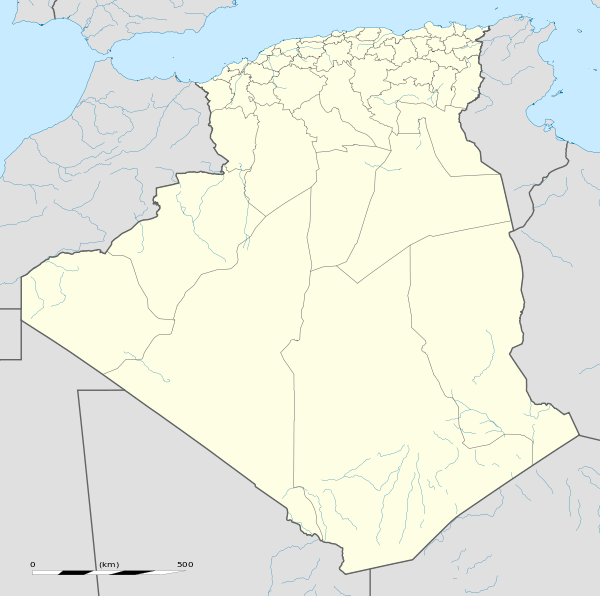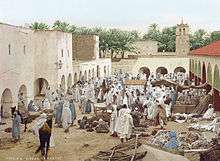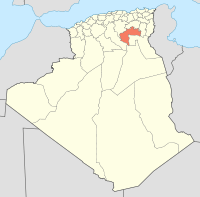Biskra
| Biskra بسكرة ⴱⵉⵙⴽⵔⴰ | |
|---|---|
| City | |
|
Biskra skyline | |
 | |
 Biskra Location in Algeria | |
| Coordinates: 34°51′N 5°44′E / 34.850°N 5.733°E | |
| Country |
|
| Province | Biskra Province |
| District | Biskra District |
| Area | |
| • Total | 127.55 km2 (49.25 sq mi) |
| Elevation | 87 m (285 ft) |
| Population (2007) | |
| • Total | 307,987 |
| • Density | 2,400/km2 (6,300/sq mi) |
| Time zone | +1 (UTC+1) |
| Postal code | 07000 |
| Climate | BWh |
Coordinates: 34°51′N 5°44′E / 34.850°N 5.733°EBiskra (Arabic: بسكرة ; Berber: ![]() Tibeskert) is the capital city of Biskra Province, Algeria. In 2007, its population was recorded as 307,987.
Tibeskert) is the capital city of Biskra Province, Algeria. In 2007, its population was recorded as 307,987.
History
During Roman times the town was called Vescera,[1] though this may have been simply a Latin transliteration of the native name. Around 200 AD under Septimius Severus' reign, it was seized by the Romans and became part of the province of Numidia. As a major settlement in the border region, it was significant even then. Its name was apparently bowdlerized by the Romans to Ad Piscīnam ("at the piscīna"), implying the presence of important waterworks.[1] A significant portion of the inhabitants descend from the Arab bedouin tribe of Banu Hilal,[2] others are mainly Chaoui Berbers.

In 1844, Biskra became a French garrison.[3] As of 1935, Biskra was an inland town, the principal settlement of a Saharan oasis watered by the intermittent Oued Biskra. In 1911, it was described as the Nice, France of Algiers.[1] It is in the southern part of the Algerian rail system, and a favourite winter resort. Large quantities of fruit, especially dates and olives, were grown in the vicinity.[1] The town was a military post, and was the scene of severe fighting in the rebellions of 1849 and 1871.
Culture
The inhabitants are also Ouled Naïl or Chaamba living in Biskra, M'Sila and in Saharan Atlas.
In culture
Biskra is the setting of key sections of André Gide's 1902 novel The Immoralist and lesser known 1897 prose-poem Les nourritures terrestres (The Fruits of the Earth), and he visited the town in 1895 (for a fortnight from 31 January) with Lord Alfred Douglas, following a meeting with Oscar Wilde in Blida and Algiers.
The Hungarian composer Béla Bartók collected traditional music in Biskra in 1913.
The Polish composer Karol Szymanowski, who traveled to North Africa, seemed to have been quiet impressed by Biskra.This trip probably aroused a genuine interest for the North African/ Arabic culture. He composed many pieces influenced by his experience there. He sent a post card from Biskra on April 11th, 1914.
Diana Mayo, protagonist of Edith Maude Hull's popular 1919 novel The Sheik, starts her journey into the desert from Biskra.
Population
| Year | Population[4] |
|---|---|
| 1901 | 7,500 |
| 1911 | 20,000 |
| 1926 | 22,000 |
| 1931 | 18,900 |
| 1936 | 21,300 |
| 1948 | 36,400 |
| 1954 | 52,500 |
| 1966 | 59,300 |
| 1977 | 77,000 (town) 90,500 (municipality) |
| 1987 | 128,300 |
| 1998 | 177,600 |
| 2010 | 300,000 |
Climate
Biskra has a hot desert climate (Köppen climate classification BWh), with very hot summers and mild winters. Summers are dry, and the town's light rainfall of 129 millimetres (5.1 in) is spread fairly evenly over the rest of the year. With January temperatures averaging 11 °C, Biskra is a common holiday spot in winter. Located in north-eastern Algeria on the northern edge of the Sahara Desert, the area surrounding it is very arid and most of the population lives in oasis.
| Climate data for Biskra (1976–2005, extremes 1878–present) | |||||||||||||
|---|---|---|---|---|---|---|---|---|---|---|---|---|---|
| Month | Jan | Feb | Mar | Apr | May | Jun | Jul | Aug | Sep | Oct | Nov | Dec | Year |
| Record high °C (°F) | 26.0 (78.8) |
31.0 (87.8) |
34.8 (94.6) |
42.0 (107.6) |
45.3 (113.5) |
47.2 (117) |
51.0 (123.8) |
49.0 (120.2) |
46.0 (114.8) |
40.5 (104.9) |
35.3 (95.5) |
27.5 (81.5) |
51.0 (123.8) |
| Average high °C (°F) | 16.7 (62.1) |
19.1 (66.4) |
22.6 (72.7) |
26.1 (79) |
31.3 (88.3) |
37.0 (98.6) |
40.2 (104.4) |
39.6 (103.3) |
34.3 (93.7) |
28.3 (82.9) |
21.6 (70.9) |
17.5 (63.5) |
27.9 (82.2) |
| Daily mean °C (°F) | 11.8 (53.2) |
13.7 (56.7) |
16.4 (61.5) |
19.9 (67.8) |
24.8 (76.6) |
29.9 (85.8) |
33.2 (91.8) |
32.8 (91) |
28.2 (82.8) |
22.3 (72.1) |
16.3 (61.3) |
12.5 (54.5) |
21.8 (71.2) |
| Average low °C (°F) | 6.9 (44.4) |
8.6 (47.5) |
11.4 (52.5) |
14.6 (58.3) |
19.4 (66.9) |
24.3 (75.7) |
27.4 (81.3) |
27.3 (81.1) |
23.2 (73.8) |
17.9 (64.2) |
12.1 (53.8) |
8.1 (46.6) |
16.8 (62.2) |
| Record low °C (°F) | −3.0 (26.6) |
−0.5 (31.1) |
1.3 (34.3) |
3.0 (37.4) |
5.0 (41) |
12.0 (53.6) |
16.1 (61) |
15.0 (59) |
11.0 (51.8) |
4.2 (39.6) |
1.0 (33.8) |
−5.0 (23) |
−5.0 (23) |
| Average precipitation mm (inches) | 17.4 (0.685) |
10.2 (0.402) |
13.6 (0.535) |
13.1 (0.516) |
11.1 (0.437) |
5.1 (0.201) |
1.7 (0.067) |
5.7 (0.224) |
10.4 (0.409) |
11.3 (0.445) |
20.1 (0.791) |
9.1 (0.358) |
128.8 (5.071) |
| Average precipitation days (≥ 0.1 mm) | 3.7 | 3.2 | 3.5 | 3.3 | 2.8 | 2.3 | 0.6 | 1.6 | 3.2 | 3.8 | 3.8 | 3.7 | 35.5 |
| Average relative humidity (%) | 57 | 50 | 44 | 39 | 34 | 31 | 27 | 31 | 41 | 48 | 55 | 59 | 43 |
| Mean monthly sunshine hours | 223.2 | 223.2 | 260.4 | 282.0 | 319.3 | 333.0 | 362.7 | 328.6 | 270.0 | 266.6 | 213.0 | 210.8 | 3,292.8 |
| Mean daily sunshine hours | 7.2 | 7.9 | 8.4 | 9.4 | 10.3 | 11.1 | 11.7 | 10.6 | 9.0 | 8.6 | 7.1 | 6.8 | 9.0 |
| Source #1: World Meteorological Organization (average temperatures and precipitation, 1976–2005),[5] NOAA (mean temperatures, 1965-1990),[6] | |||||||||||||
| Source #2: Arab Meteorology Book (humidity and sun),[7] Meteo Climat (record highs and lows)[8] | |||||||||||||
References
- This article incorporates text from The Modern World Encyclopædia: Illustrated (1935); out of UK copyright as of 2005.
- 1 2 3 4 "Street in the Old Town, I, Biskra, Algeria". World Digital Library. 1899. Retrieved 2013-09-25.
- ↑ "Qui sont les Hilaliens ou les Banu Hilal". www.amazighworld.org. Retrieved 2015-09-26.
- ↑ "Market, Biskra, Algeria". World Digital Library. 1899. Retrieved 2013-09-25.
- ↑ populstat.info
- ↑ "World Weather Information Service–Biskra". World Meteorological Organization. Retrieved 17 October 2016.
- ↑ "Climate Normals for Biskra". Retrieved 11 February 2013.
- ↑ "Appendix I: Meteorological Data" (PDF). Springer. Retrieved 17 October 2016.
- ↑ "Station Biskra" (in French). Meteo Climat. Retrieved 17 October 2016.
External links
![]() Media related to Biskra at Wikimedia Commons
Media related to Biskra at Wikimedia Commons
| Wikisource has the text of the 1911 Encyclopædia Britannica article Biskra. |
- (French) Biskra City
